Increasing Productivity, Connection To Nature And Other Humans Via Biophilic Interior Design
So, for starters, what is the definition of “Biophilic”?
The term “biophilic” is derived from the word “biophilia,” which was coined by biologist E.O. Wilson in his 1984 book “Biophilia.” Biophilia refers to the innate human tendency to seek connections with nature and other forms of life. It suggests that humans have an inherent affinity for nature and a desire to be close to natural environments, species and processes.
The term “biophilic” is used to describe anything that relates to or promotes this concept of biophilia. In the context of architecture and interior design, “biophilic” refers to incorporating elements of nature and natural processes into the built environment to enhance human well-being, reduce stress and create a more harmonious and appealing living or working space.
For example, “biophilic design” refers to the approach of designing spaces that incorporate natural materials, patterns, light, plants and other elements to create a sense of connection to the natural world and to enhance the overall experience of the space. Similarly, “biophilic architecture” involves designing buildings that integrate with their natural surroundings and incorporate features that promote human well-being through a stronger connection to nature.
In essence, “biophilic” signifies the recognition of our inherent connection to nature and the conscious effort to bring the benefits of that connection into our constructed environments.
Learn More: What are natural material rugs | Verdure Tapestries – Immersing Yourself Natural Green Pastures | Paula Hayes Terrarium Designer and Artist
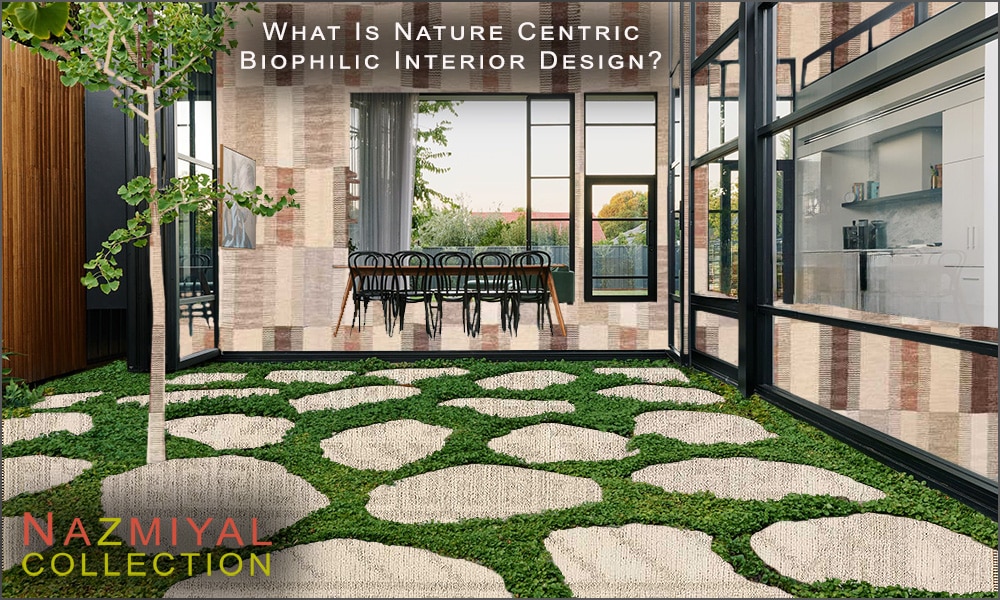
What is Nature Centric Biophilic Interior Design?
What are biophilic principles?
Biophilic principles are fundamental concepts and guidelines that inform the design of spaces to enhance the connection between humans and the natural world. These principles draw inspiration from the innate human affinity for nature and aim to create environments that promote well-being, creativity and a sense of harmony with the surrounding natural environment.
Here are some key biophilic principles:
- Visual Connection to Nature: Incorporate views of nature, whether through windows, skylights, or artwork depicting natural scenes.
- Natural Light and Shadow: Maximize the use of natural daylight to create a positive and dynamic atmosphere. Also, incorporate shadows and changing patterns of light that mimic natural conditions.
- Presence of Water: Integrate water elements such as fountains, indoor ponds, or water features to evoke a calming and refreshing ambiance.
- Biomorphic Forms and Patterns: Use design elements that mimic natural shapes and patterns, such as curves, spirals and fractals.
- Natural Materials and Textures: Incorporate natural materials like wood, stone and organic textiles to create a tactile connection to nature.
- Sensory Diversity: Engage multiple senses by introducing elements like textured surfaces, natural scents and soothing sounds.
- Complexity and Order: Balance intricate details with organized and recognizable patterns to create a sense of comfort and intrigue.
- Prospect and Refuge: Design spaces that offer a mix of open views and sheltered areas to provide a sense of security and curiosity.
- Cultural and Contextual Relevance: Incorporate design elements that reflect the local environment, culture and history.
- Connection to Seasonal Changes: Design spaces that adapt to and reflect the changing seasons, embracing the dynamic nature of the natural world.
- Interactions with Nature: Create spaces that encourage interaction, movement and exploration, similar to experiences in natural settings.
- Sustainable Design: Prioritize environmentally-friendly design practices that minimize the ecological impact of the built environment.
- Symbolism and Storytelling: Incorporate elements that tell stories about the natural world or cultural connections, fostering a deeper connection to the space.
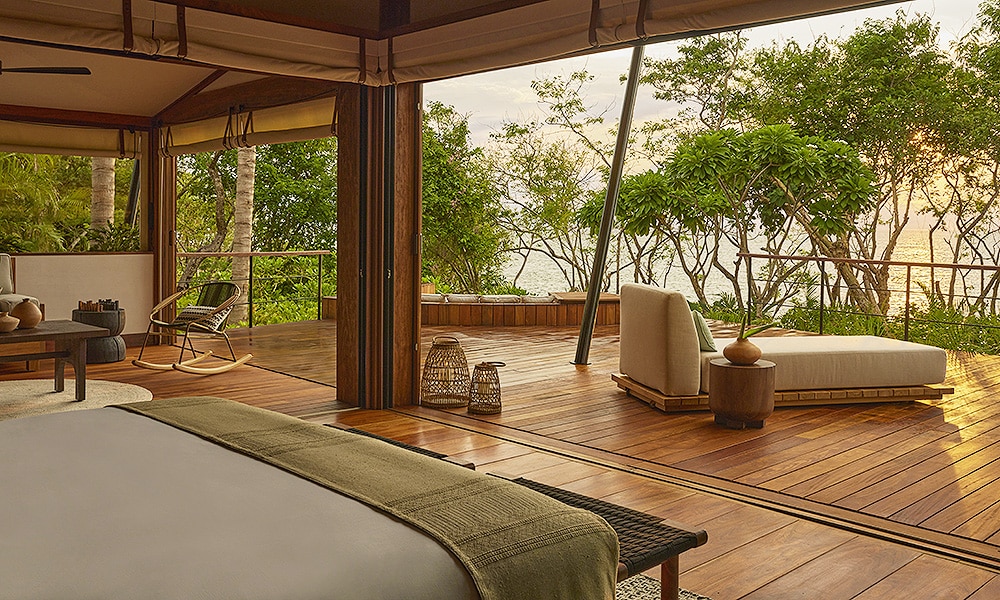
Luxury Biophilic Costal Interior Design
These principles can be applied across various types of spaces, from residential homes and offices to public areas and healthcare facilities. By adhering to these biophilic principles, designers and architects aim to create environments that improve well-being, cognitive function and emotional satisfaction by fostering a stronger connection to the natural world.
Then what is biophilic interior design?
Biophilic interior design is a concept that incorporates elements of nature and natural environments into indoor spaces, creating a stronger connection between human beings and the natural world. The term “biophilia” was coined by biologist E.O. Wilson and it refers to the inherent human inclination to seek a connection with nature and other forms of life.
Biophilic interior design goes beyond just adding a few potted plants; it involves a holistic approach to designing spaces that evoke the feeling of being surrounded by nature.
Some key principles and elements of biophilic design include:
- Natural Materials: Using materials like wood, stone, water and natural textiles to mimic the textures and qualities of the outdoors.
- Natural Light: Maximizing natural daylight and using strategies to control light patterns, which can positively affect mood, circadian rhythms and overall well-being.
- Indoor Plants: Incorporating a variety of plants, including both live and artificial ones, to create a sense of greenery and life within the space.
- Natural Shapes and Patterns: Incorporating organic shapes and patterns inspired by nature, such as fractals, waves and spirals, into architectural elements and decor.
- Water Features: Integrating water elements like fountains, ponds, or indoor waterfalls to create a calming and soothing ambiance.
- Views of Nature: Incorporating views of nature, whether through windows or artwork, to provide a visual connection to the outdoors.
- Biomorphic Forms: Using furniture and design elements that are inspired by natural forms, such as furniture that mimics the shape of rocks or leaves.
- Natural Colors: Choosing a color palette inspired by the natural world, including earthy tones, greens, blues and neutral hues.
- Texture and Sensory Engagement: Incorporating tactile materials and textures that engage the senses, such as rough stones, smooth wood, or soft fabrics.
- Dynamic and Interactive Spaces: Creating spaces that allow for movement, exploration and interaction, similar to how people engage with nature.
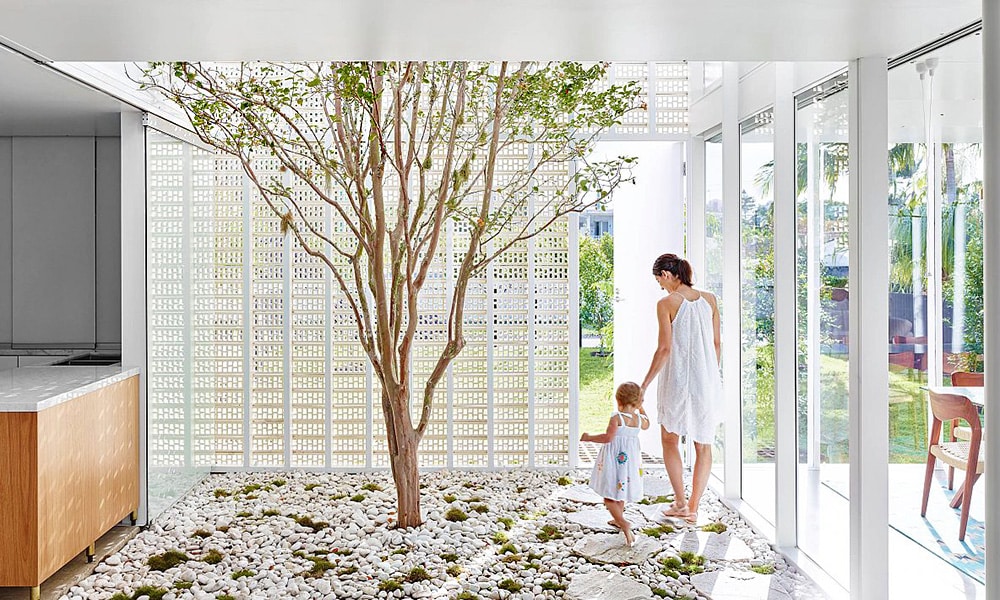
Reconnecting With Nature With Biophilic Home Design
The goal of biophilic interior design is to improve the overall well-being and productivity of individuals by creating spaces that nurture a deeper connection to nature. This design approach has gained popularity due to its potential to reduce stress, enhance cognitive function and promote emotional well-being in various indoor environments, such as homes, offices, healthcare facilities and public spaces.
Who is credited with being the creator of biophilic design?
Biophilic design is not attributed to a single creator, but rather it emerged as a concept that builds upon various fields such as architecture, psychology and environmental studies. However, the biologist and naturalist E.O. Wilson played a significant role in popularizing the idea of biophilia, which laid the foundation for biophilic design.
In 1984, E.O. Wilson published a book titled “Biophilia,” in which he introduced the concept of biophilia as the innate human connection to nature and other living beings. He argued that humans have an evolutionary affinity for nature due to our long history of interaction with natural environments. This concept inspired architects, designers and researchers to explore how the principles of biophilia could be integrated into the design of built environments to improve human well-being.
While E.O. Wilson’s work was instrumental in shaping the understanding of biophilia, biophilic design itself has been developed and expanded upon by various architects, designers, researchers and practitioners over the years. The term “biophilic design” started to gain traction in architectural and design circles as professionals began to explore and implement design strategies that align with the principles of biophilia to create more human-centered and nature-inspired spaces.
What is the concept of biophilic design?
The concept of biophilic design revolves around the idea of integrating nature and natural elements into the built environment to enhance human well-being, improve cognitive function and foster a stronger connection to the natural world. It acknowledges the innate human affinity for nature and seeks to create spaces that tap into this connection, even in urban and indoor settings. Biophilic design is based on the notion that being in proximity to nature has numerous positive effects on human health, productivity and overall quality of life.
Here are some key principles and concepts that define biophilic design:
- Biophilic Patterns: Biophilic design identifies certain patterns found in nature that can be incorporated into architectural and interior design. These patterns include fractals (repeated geometric shapes), natural forms (like curves and arches) and the use of biomorphic shapes and structures.
- Nature-Inspired Materials: The use of natural and organic materials, such as wood, stone, water and natural fabrics, helps create a connection to the outdoors and brings a sense of authenticity to indoor spaces.
- Natural Light: Maximizing access to natural light and ensuring that spaces are well-lit can positively impact mood, circadian rhythms and overall health. Daylighting strategies involve designing windows, skylights and light wells to optimize sunlight exposure.
- Indoor Plants and Greenery: Incorporating plants, whether through potted plants, living walls, or other arrangements, can improve air quality, reduce stress and create a calming and refreshing atmosphere.
- Views and Visual Connections: Providing views of nature, whether it’s through windows overlooking green spaces or artwork depicting natural scenes, helps establish a visual connection to the outdoors.
- Water Features: Introducing water elements like fountains, waterfalls, or indoor ponds can evoke a sense of tranquility and natural harmony.
- Sensory Engagement: Designing spaces with varying textures, sounds and scents can stimulate multiple senses, enhancing the overall sensory experience and creating a more immersive environment.
- Dynamic and Interactive Spaces: Designing spaces that encourage movement, exploration and interaction mimics the way people engage with natural environments.
- Cultural and Contextual Relevance: Biophilic design can also incorporate elements of the local environment, culture and history to create a unique and meaningful connection to the space.
- Holistic Well-being: The ultimate goal of biophilic design is to improve holistic well-being by reducing stress, enhancing cognitive function, boosting creativity and fostering a sense of connection to nature.
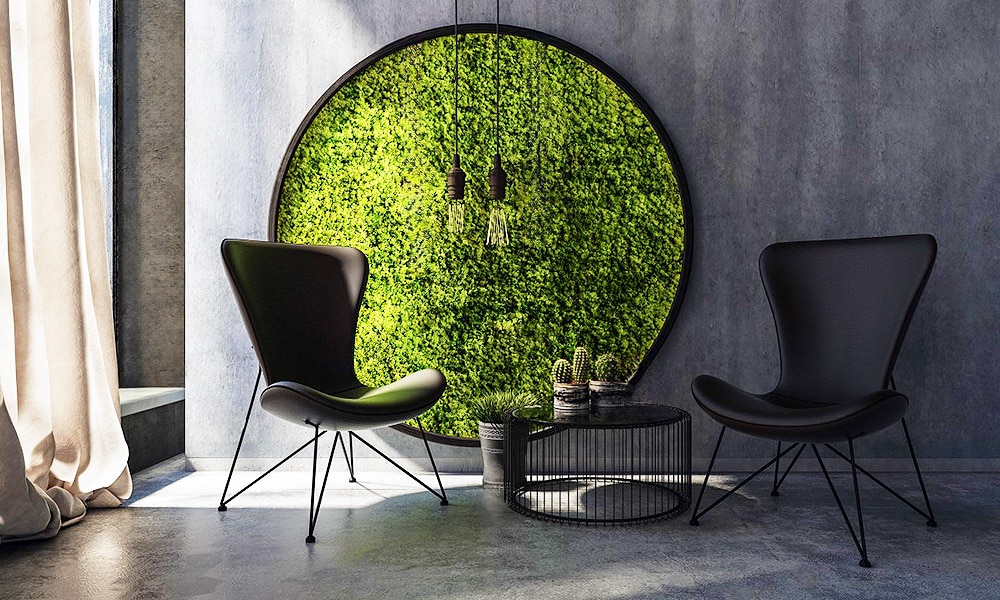
Biophilic Nature Elements in Industrial Interior Design
Biophilic design can be applied to a range of settings, from homes and workplaces to schools, healthcare facilities and public spaces. Its principles can be adapted to various architectural styles and interior design preferences, making it a versatile approach to creating healthier and more inspiring environments.
What are some example of biophilic design?
Here’s an example of a biophilic design for an office space:
- Office Atrium with Vertical Garden: Imagine an office building with a large central atrium that spans several floors. This atrium is designed to incorporate various biophilic elements to create a welcoming and rejuvenating environment for employees.
- Vertical Garden: One entire wall of the atrium is covered with a lush vertical garden consisting of a variety of plants and vines. This not only brings a vibrant touch of nature indoors but also improves air quality and provides a visual connection to greenery.
- Natural Light: The atrium features a large skylight that allows ample natural light to filter through. This ensures that the space is well-lit during the day and that employees can experience the changing patterns of natural light.
- Water Feature: At the center of the atrium, a small water feature is incorporated, such as a tranquil pond or a flowing stream. The sound of trickling water adds a soothing auditory element and reinforces the connection to nature.
- Biophilic Patterns: The architectural design of the atrium incorporates fractal patterns found in nature, such as branching structures in the supporting columns or decorative elements that mimic the shape of leaves.
- Greenery Throughout: In addition to the vertical garden, potted plants are strategically placed around the atrium and in various office areas. This brings a touch of nature to every corner of the workspace.
- Natural Materials: The use of natural materials, such as wooden flooring, stone accents and natural textiles, adds warmth and authenticity to the space.
- Seating and Interaction Areas: Comfortable seating areas are scattered throughout the atrium, providing employees with places to work, collaborate, or simply relax. The seating is designed to encourage interaction and movement.
- Views of Nature: The office spaces surrounding the atrium have large windows that offer views of the greenery and water features. This creates a visual connection to nature even for those working indoors.
- Sensory Elements: Essential oils or natural scents are diffused into the air, creating a pleasant olfactory experience that complements the visual and auditory aspects of the design.
- Cultural References: Artwork or design elements inspired by local flora and fauna pay homage to the natural environment of the region and create a sense of place.
This example illustrates how biophilic design can be integrated into an office environment to promote employee well-being, creativity and productivity. The combination of natural elements, light, water and greenery creates a holistic and harmonious workspace that fosters a strong connection to nature, even within an urban setting.
Learn More: Creating Indoor Garden Spaces and Interiors | Delancey Underground: A Subterranean Green Space |
What interior design styles incorporate Biophilic principals?
Several interior design styles incorporate Biophilic principles, which emphasize the connection between humans and nature. Biophilic design aims to create spaces that promote well-being, reduce stress and enhance overall quality of life by integrating natural elements into the built environment.
Here are some interior design styles that often incorporate Biophilic principles:
- Modern Rustic: This style combines natural materials like wood and stone with modern design elements. It often features large windows to allow ample natural light in and provides a seamless transition between indoor and outdoor spaces.
- Scandinavian: Known for its simplicity, the Scandinavian design style emphasizes light, neutral color palettes, natural textures and the use of indoor plants to bring a sense of nature into living spaces.
- Tropical and Coastal: These styles embrace a relaxed, beach-inspired atmosphere with elements like woven materials, light colors and an abundance of plants. They aim to create a vacation-like ambiance.
- Japanese Zen: Inspired by Japanese aesthetics, this style focuses on simplicity, minimalism and tranquility. It often incorporates indoor gardens, natural materials and a sense of balance and harmony.
- Mid-Century Modern: This style combines sleek, clean lines with organic shapes and materials. Large windows and open spaces help create a connection with the outdoors, while indoor plants and natural wood elements are commonly used.
- Minimalism: Minimalist design often incorporates a sense of calm and simplicity, which can align well with Biophilic principles. Limited use of materials and a focus on functionality can create a serene environment.
- Eclectic: Eclectic design allows for the incorporation of various styles, including elements of nature. Mixing textures, colors and patterns while including natural materials and plants can result in a visually interesting space.
- Industrial with Greenery: Industrial design typically involves exposed brick, metal and concrete. By adding plenty of indoor plants, designers can soften the harshness of these materials and bring a touch of nature indoors.
- Cottagecore: This style romanticizes rural and countryside aesthetics. It often includes floral patterns, vintage elements and rustic textures to create a cozy and nature-inspired atmosphere.
- Bohemian: The Bohemian style is characterized by its eclectic and free-spirited approach. It often incorporates indoor plants, natural textiles and a mix of cultural influences, creating a sense of connection to different places and times.
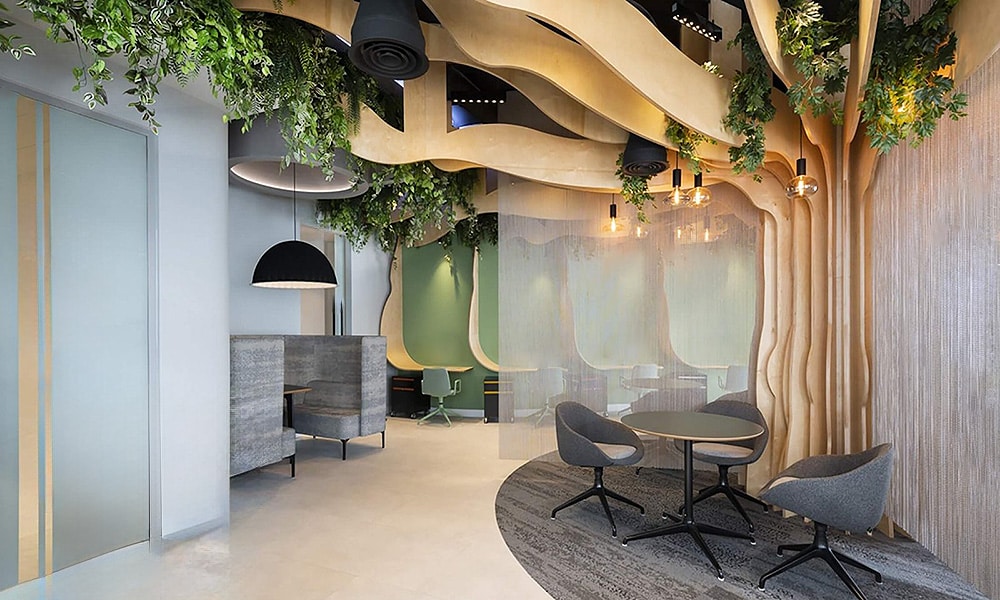
Biophilic Office Interior Design
Remember that the incorporation of Biophilic principles can vary within each style. It’s about creating a balance between natural elements, textures, colors and other design elements that evoke a connection to nature, ultimately promoting a healthier and more soothing living environment.
Learn more: Minimalism, Minimalist Interior Design And Rugs | Decorating Rustic Interiors With Rustic Rugs | Creating Beautiful Boho Chic Interiors With Modern Bohemian Area Rugs | Scandi Home Decor And Scandinavian Interior Design | Tips For Home Decorating With Scandinavian Area Rugs | Eclectic Interior Design With Area Rugs | Industrial Interior Design with the Right Rug | Exploring The Mid Century Modern Design Style | Japandi Style Design | Coastal Interior Design And Home Decor Style | Zen Decor For The Home
Are “Biophilic design” and “Biophilia design” the same?
Yes, “Biophilic design” and “Biophilia design” are essentially the same concept, both referring to the design approach that incorporates elements of nature and the natural world into the built environment to improve human well-being and foster a stronger connection to nature. The terms are often used interchangeably to describe the practice of creating spaces that tap into our innate affinity for nature.
“Biophilic design” is the more commonly used term and is widely recognized in the fields of architecture, interior design and urban planning. It emphasizes the design principles and strategies employed to create spaces that engage our senses and evoke the feelings of being in nature.
“Biophilia design” can also be used to convey the same idea, although it might be slightly less common in professional design discourse. Nevertheless, both terms refer to the practice of integrating natural materials, patterns, colors, lighting and other elements into the design of spaces in order to create environments that promote well-being, reduce stress and enhance our connection to the natural world.
Which types of area rugs work best in Biophilic interior design?
In biophilic interior design, the goal is to create a connection with nature and evoke a sense of being surrounded by natural elements. When it comes to choosing area rugs that align with this design approach, it’s important to select rugs that reflect the textures, colors and patterns found in the natural world.
Here are some types of area rugs that work well in biophilic interior design:
- Natural Fiber Rugs: Rugs made from natural fibers such as wool, silk or bamboo bring an earthy and organic texture to the space. These rug weaving materials are not only sustainable but also evoke a sense of walking on natural terrain.
- Earth-Toned Rugs: Choose more earthy colored area rugs with color palettes inspired by the natural environment, such as earthy browns, greens, blues and neutral tones. These colors create a harmonious connection to nature.
- Organic Patterns: Look for different types and styles of area rugs with patterns that mimic natural forms, such as leaves, waves, or abstract representations of landscapes. These patterns can evoke a sense of being in an outdoor setting.
- Abstract Nature Motifs: Rugs featuring abstract deigns and interpretations of natural elements, like flowing water, rock formations, or tree branches, can add a touch of nature-inspired artistry to the space.
- Floral and Botanical Prints: Finer area rugs with subtle or abstract floral and botanical prints can introduce a sense of natural vitality and growth.
- Textured Rugs: Area rugs with varying textures, such as shag rugs or even the fine and rare souf area rugs with their raised patterns, can mimic the sensation of walking on natural surfaces like grass or pebbles.
- Wood-Inspired Rugs: Rugs and carpets that incorporate wood-like patterns or textures can evoke the feeling of walking through a forest or on wooden pathways.
- Nature-Inspired Materials: Consider eco friendly area rugs made from reclaimed materials or those that combine different natural materials to create a multi-textured and visually engaging design.
- Water-Themed Rugs: Area rugs featuring designs and patterns of water ripples, ocean waves, or serene ponds can bring a calming aquatic element to the space.
- Seasonal Rugs: Depending on the season, you could choose different types of area rugs that reflect the characteristics of that time of year, whether they be warmer autumnal colors, winter whites, spring blossoms, or summer greens.

Oriental Area Rug in Scandinavian Biophilic Interior Design
When choosing the perfect area rugs for a biophilic interior design, keep in mind that the area rug styles you settle on should contribute to the overall harmony of the space and evoke a sense of connection to the natural world. The texture, color, pattern and material used to make the rugs should work together to create a cohesive and inviting environment that aligns with the principles of biophilic design.
Learn more: How To Choose An Area Rug Color | Area Rug Patterns And Motifs |
Shop Antique Rugs | Shop Modern Rugs | Shop Vintage Rugs | Create Custom Rugs | Shop Floral Rugs |
What are some famous examples of biophilic interior design?
Several famous examples of biophilic interior design showcase how the principles of nature-inspired design have been incorporated into various spaces.
Here are a few notable biophilic interior examples:
Amazon Spheres – Seattle, Washington, USA: The Amazon Spheres in Seattle serve as a workspace and conservatory for Amazon employees. These futuristic glass domes house a variety of plant species and trees, creating a lush indoor garden environment that offers employees a unique and refreshing workspace.

Inside Amazon Biophilic Spheres in Seattle WA
SAC Federal Credit Union – Papillion, Nebraska, USA: The headquarters of SAC Federal Credit Union features a biophilic design that includes a large central atrium with a vertical garden, natural materials and abundant natural light. The design emphasizes employee well-being and collaboration.
Apple Park – Cupertino, California, USA: Apple’s headquarters, Apple Park, incorporates biophilic design principles throughout its campus. The use of natural materials, extensive landscaping and large open spaces with views of greenery and outdoor spaces create a harmonious connection to nature.
Bosco Verticale – Milan, Italy: Bosco Verticale, or the Vertical Forest, is a pair of residential towers covered with over 20,000 trees and plants. This innovative design not only provides a striking visual impact but also contributes to air purification and biodiversity within an urban context.
The Spheres – Singapore: The Spheres at Gardens by the Bay in Singapore are large, futuristic glass structures housing diverse plant species from around the world. They serve as both conservatories and public attractions, providing an immersive experience of nature in an urban setting.
The Bullitt Center – Seattle, Washington, USA: The Bullitt Center is a sustainable office building that embraces biophilic design principles, including ample natural light, wood finishes and a focus on energy efficiency. The building’s design showcases its commitment to environmental sustainability.
Lululemon Store – Chicago, Illinois, USA: The Lululemon store in Chicago incorporates biophilic elements such as natural wood finishes, living plant walls and an interior design that mimics natural landscapes. The store aims to create a calming and inviting environment for shoppers.
One Central Park – Sydney, Australia: One Central Park features vertical gardens that span the facades of the residential towers. These gardens are designed to be visible from both inside and outside the building, providing residents with a strong visual connection to nature.
These examples demonstrate how biophilic interior design has been applied in various contexts, from corporate headquarters and commercial spaces to residential buildings and urban landmarks. They showcase the versatility of biophilic design principles in creating visually appealing, health-promoting and sustainable environments.
At the end of the day, Biophilic design is all about promoting a sense of calm and wellbeing by bringing some of the healing powers of nature into our homes and incorporating more of them in our daily lives.
This interior deign blog that talks about what Biophilic interior design is, was published by Nazmiyal Rugs




